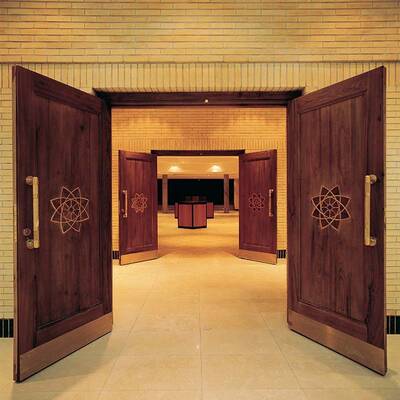
Old Gate of Tehran
TehranMany years before Safavid era Qazvin has a fort; this was affirmed by Estakhri, Yaqut Al- Hamawi, Ibn Hawqal and Naser Khosrow in their itineraries and writings and Hamdallah Mustawfi attributed it to the time of Sassanid Shapur that was later restored and repaired by Abbasid and Deylamian Kings. Mustawfi states: “its perimeter was 10000 feet”.
Many years later when Shah Tahmaseb Safavi moved the capital from Tabriz to Qazvin he constructed a wide barrier around the city with several gates for passengers and protecting the city from the possible attacks. The number of gates has been eight, based on some historians, or nine, based on others. Four gates namely Panbe Riseh or Shah, Tehran, Mughlawk or Hamedan (Kushk door) and Rasht had a brick façade and they were decorated with tiles. Other gates were not as beautiful as them to which Lord Curzon has referred in the book of Persia and the Persian Question. Among these gates, just two ones are still standing adding to the beauties of their cities: Tehran Gate and Kushk Gate.
Tehran Gate or the Old Gate of Tehran that is attributed to Qajar period had been constructed outside Qazvin City on the road of Tehran-Qazvin; passengers from Tehran, Shemiranat and Rey enter Qazvin through this Gate. In the period of Pahlavi when the city was expanded, the location of this gate changed to place in the heart of the city, however, it still remains the Old Gate of Tehran until now.
On two sides of the gate there are two facades and it has been decorated with beautiful tiles. Eight minarets that were a sign for the passengers to find their way and three entrances have been constructed in this gate. The main entrance that is larger than the others has an arc ceiling. But the ceiling of two other entrances that have symmetrically organized on two sides is semicircular. It seems each entrance to be for a special class; one for pedestrians and the other for those who were mounted or probably they opened all entrances when the passengers were too much.
Decorated with seven colored tiles on two sides and having a cobalt-blue appearance, this gate was repaired and its tiles were reconstructed in 1347 SH by Qazvin Department of Art and Culture. After moving the capital from Qazvin to Isfahan in time of Shah Abbas The Great and later due to the expanding of the city in time of Pahlavi the gate lost its importance so that it is today just an ordinary structure in the eastern entrance of the city in Hashemi square without any traffic like the past, no doors and guards. However, it is worth visiting several times. This gate was inscribed on 30 Mordad, 1354 SH as one of Iran National Heritages with Registration No. 392.
